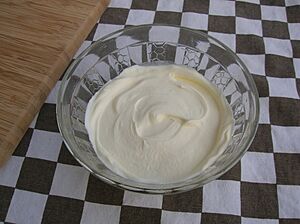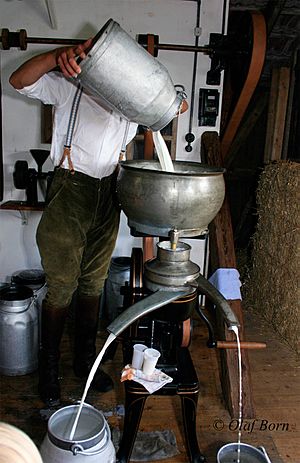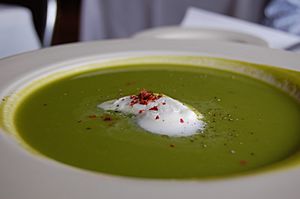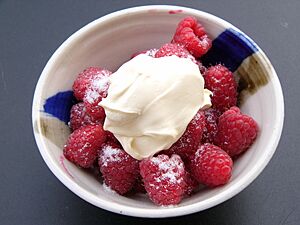Crème fraîche facts for kids
Crème fraîche (say "krem fresh") is a creamy dairy product that's a bit like sour cream. The name means "fresh cream" in French. It's made by adding a special kind of bacteria to regular cream, which makes it slightly thick and tangy.
Crème fraîche usually has a good amount of fat, between 10% and 45%. This high fat content helps it stay smooth when heated, so it's great for cooking. You can enjoy it with fruits and baked goods, or add it to soups and sauces to make them richer. It's similar to sour cream, but crème fraîche is usually less sour and has more fat. Also, in many places, crème fraîche is only allowed to have cream and bacteria as ingredients, while sour cream might have other thickeners.
The name crème fraîche comes from France. However, similar types of soured creams are popular in many parts of northern Europe. For example, in Central America, there's a traditional soured cream called crema fresca that is quite similar.
Contents
What Does "Crème Fraîche" Mean?
In French-speaking countries, the term crème fraîche can mean two different things:
- Thick, fermented cream: This is the kind we usually think of as crème fraîche, often called crème fraîche épaisse (thick fresh cream) or fermentée (fermented).
- Liquid cream: This is just regular, unfermented liquid cream, sometimes called crème fraîche liquide or fleurette.
In France, if someone just says crème fraîche, they usually mean the liquid cream. The thick, fermented version is often called crème épaisse. But in most other countries, when people say crème fraîche, they are talking about the thick, fermented product.
How Crème Fraîche Is Made
Making crème fraîche is a simple process. First, a special group of bacteria, called a starter culture, is added to heavy cream. These bacteria are very important because they give crème fraîche its unique tangy flavor. Some of the common bacteria used include types of Lactococcus.
After the bacteria are added, the cream is left to sit at a certain temperature. Over time, the bacteria work their magic, making the cream thicker and giving it that slightly sour taste. For people who want to make it at home, you can even use cultured buttermilk (which already has active bacteria) instead of a special starter culture.
In many parts of Europe, there are strict rules about how crème fraîche is made. These rules often say that only cream and the starter culture can be used. This means no extra ingredients like thickeners or stabilizers are allowed.
However, in places like North America and the UK, you might find "low-fat crème fraîche." This version has less fat (around 15%) and often has extra ingredients called stabilizers, like xanthan gum or corn starch. These stabilizers help make the low-fat version thick, but it might not hold up as well when heated compared to regular crème fraîche.
Why Crème Fraîche Is Thick and Stable
Crème fraîche gets its thick texture from the way the cream and bacteria interact. When the bacteria make the cream more acidic, the milk proteins (called casein) start to clump together. This creates a kind of gel that traps the fat globules in the cream.
This gel structure is what makes crème fraîche so stable and thick. It's especially strong in creams with higher fat content (around 30% or more). That's why it's hard to make low-fat crème fraîche without adding extra stabilizers to get the same creamy texture. Also, the fat in cream contains tiny solid pieces called triglycerides, which help make the cream even stiffer when it's cold.
Famous Crème Fraîche Regions
The region of Normandy in France is very famous for its crème fraîche. In particular, the crème fraîche from a specific area around the town of Isigny-sur-Mer in Normandy is highly prized. It's so special that it has a protected status called an appellation d'origine contrôlée (AOC), which means it must be produced in a certain way in that specific area to use the name. This special status was given in 1986.
Crème fraîche is also made in many other parts of France, especially in major dairy regions like Brittany, Poitou-Charentes, Lorraine, and Champagne-Ardenne.
How Crème Fraîche Is Used
Crème fraîche is a very versatile ingredient in French cuisine, meaning it can be used in many different ways. You can use it both hot and cold.
When used in hot savory sauces, its high fat content (usually more than 30%) means it won't curdle or separate easily, which is a common problem with lower-fat creams. This makes it perfect for finishing off rich sauces. It's also a key ingredient in many delicious desserts and dessert sauces, adding a creamy, tangy touch.
Similar Dairy Products
There are other soured cream products around the world that are similar to crème fraîche:
- Crema Mexicana: This is a cultured sour cream from Mexico that can sometimes include other ingredients.
- Smetana: Found in Eastern Europe and Russia, smetana is very similar to crème fraîche. In Romania and Moldova, it's called smântână.
See also
 In Spanish: Crème fraîche para niños
In Spanish: Crème fraîche para niños
Images for kids






